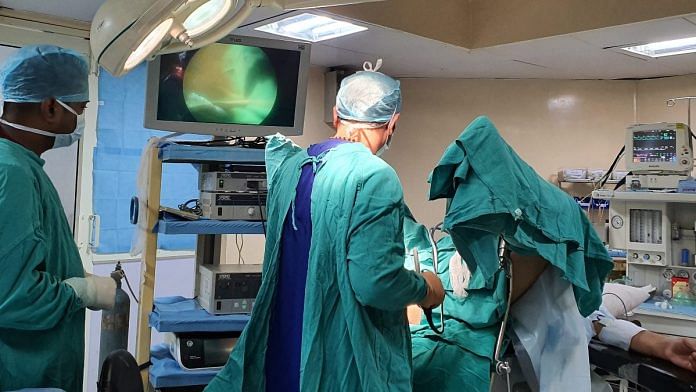New Delhi: The National Medical Commission (NMC) has decided to form a panel to decide its stand over the live broadcast of surgical procedures, a senior official of the regulatory body said Tuesday.
Dr Yogender Malik of the NMC’s Medical Ethics and Registration Board said the Supreme Court had sought its view on the matter but there were contrasting opinions among members.
On 13 October, the top court had sought a response from the Centre and others, including the NMC, on a plea that raised legal and ethical questions over the live broadcast of surgical procedures. The petitioners had compared surgeons interacting with audiences while performing procedures to cricketer Virat Kohli batting and commentating at the same time. The public interest litigation (PIL) was filed by several Delhi residents.
Petitioner Dr Rahil Choudhary told ThePrint that live surgeries were meant to “glorify and benefit surgeons” at the cost of patients, who are convinced to take part in such demonstrations with the promise of free procedures.
“During live surgeries that are telecast in conferences, hundreds of doctors are allowed to interact with the operating surgeon, who keeps taking questions from the audience,” he said, arguing that this may distract the doctor.
“These demonstrations are often sponsored by medical device-makers… and are not in the interest of patients at all,” he said.
Choudhary, an ophthalmologist, referred to the death of a patient at the All India Institute of Medical Sciences during one such live procedure in 2015. He added that many countries had already banned the practice, but there was no clear regulation on this in India.
He said live procedures were formerly carried out only by a small association of doctors, but the All India Ophthalmological Society (AIOS) — the country’s largest network of eye doctors — had performed one last month.
“This triggered our petition as we cannot allow this practice to be adopted by large associations of doctors… On many occasions, surgeries are botched during live broadcasts but are not highlighted, as that would show doctors in a bad light,” he said.
Choudhary also said that instead of live surgeries, pre-recorded procedures can be shown to doctors in order to upskill them.
When contacted, AIOS president Dr Harbansh Lal said that “there is no better tool than live surgeries to transfer the surgery skill and build confidence among doctors”.
“Even when a surgery is not shown live in a conference, in medical colleges, it is shown to residents and learning doctors routinely,” he said.
As far as stress on surgeon is concerned during a live procedure, Lal said this was part and parcel of modern life.
“Aren’t surgeons carrying out procedures on VIP patients under added stress,” he asked, adding that surgeons demonstrating procedures in conferences are top-of-the line doctors and can handle stress very well.
On live surgeries being sponsored by device makers, Lal said that this was permitted under the NMC regulations.
“If NMC or the Supreme Court comes up with the directive that such practices should be stopped, we will follow the guidelines but in my view there is nothing wrong in training thousands of doctors, who may not always have access to high-quality training programmes, through such procedures,” Lal said.
There are other doctors, too, who approve of live procedures provided they meet certain conditions. Dr R.V. Asokan, president-elect of the Indian Medical Association, the largest body of doctors in the country, said there should be quality and informed consent of the patients for live teach-ins.
“We should keep in mind that dissemination of knowledge and skills is the only way to teach the next generation of students. Advanced techniques of media and communication have to be put to full use to benefit many learners,” he told ThePrint.
(Edited by Tikli Basu)



